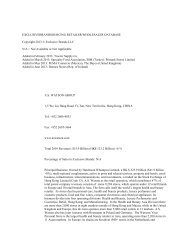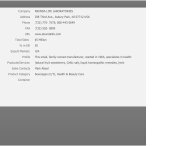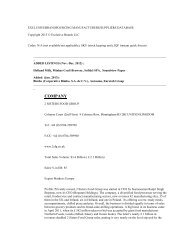EXCLUSIVEBRANDSOURCING RETAILER/WHOLESALER ...
EXCLUSIVEBRANDSOURCING RETAILER/WHOLESALER ...
EXCLUSIVEBRANDSOURCING RETAILER/WHOLESALER ...
Create successful ePaper yourself
Turn your PDF publications into a flip-book with our unique Google optimized e-Paper software.
culminating in 1999 with a controlling interest taken in the Gucci Group N.V—raised to 99% in<br />
2004. Today, PPR operates as a multinational holding company directly operating retail shops<br />
dedicated to its brands, which also are sold within boutiques in a limited selection of department<br />
stores and specialty stores. In 2011, PPR operated 801 stores, up from 684 in 2010: 192 in<br />
Western Europe, 142 in North America, 214 in Japan, and 253 in emerging countries. Its most<br />
powerful luxury brand, Gucci (64% of revenues) is sold exclusively through 376 directly operated<br />
Gucci stores, which command 74% of that brand’s total revenues of € 3.1 billion (+14.8%). The<br />
balance of Gucci sales (leather goods, shoes, ready-to-wear apparel, watches, and jewelry) comes<br />
from the small number of department and specialty stores so assigned by the company. PPR’s next<br />
biggest luxury brand, Bottega Venet a (mostly leather goods) generated revenues of € 683 million<br />
(+33.7%) sold primarily in 170 directly operated stores. Its other big luxury, fashion apparel<br />
brand, Yves Saint Laurent with revenues of € 354 million (+31.6%) is sold in 83 directly operated<br />
boutiques (56% of sales), and in multi-brand boutiques and department stores worldwide. Six<br />
other PPR luxury brands, sold in 172 directly operated stores, generated € 738 million in revenues<br />
(+30.6%). They are: Balenciago (ready to wear apparel), Sergio Rossi (footwear and accessories),<br />
Boucheron (jewelry and watches), Alexander McQueen (women’s wear and accessories), and<br />
Shella McCartney (lifestyle ready-to-wear apparel and accessories). In its Sports & Lifestyle<br />
Division, most of the revenues are generated by the Puma brand in footwear and apparel (€ 3<br />
billion +11.1%) which is sold like a brand without any dedicated company operate stores.<br />
Additionally, PPR operates ‘fnac,’ a distributor of cultural, leisure and technological products such<br />
as books, music, and personal computers in 154 directly operated stores (€ 4.2 billion -2.2%).<br />
EB Identities: Gucci, Bottega Veneta, Balenciago, Boucheron, Sergio Rossi, Alexander McQueen,<br />
Stella McCartney, Yves Saint Laurent, etc.<br />
EB skus: N/A<br />
Profile: PPR recorded an “excellent year,” its recurring operating income up by 16.9% to € 1.6<br />
billion, as the company regroups into two major divisions: Luxury Goods and Sports & Lifestyle<br />
Merchandise. Its 2020 goal: to reach € 24 billion in revenues, 60% in the former and 40% in the<br />
latter division. In March 2011, PPR Home was established to set new standards and business<br />
practices and sustainability goals in both those divisions. Late in 2010, the private company<br />
decided to sell its Conforma operation, the second largest furniture retailer in France (186 stores)<br />
plus other stores in total some eight other countries. Its outlets sell household goods (#1 in France)<br />
and domestic appliances (#2 in France)—and feature private label merchandise as well. A $1.6<br />
billion deal was negotiated with Steinhoff, South Africa’s largest furniture maker, and<br />
consummated in March 2010. PPR, during 2011, acquired Volcom in July, an action sports brand<br />
(€ 147 million in revenues) and increased its stake in the Sowind Group (Girard-Perregaux and<br />
Jean Richard), a high-end watch movement producer. Girard-Perregaux traces its history back to<br />
1791. The Gucci brand, celebrating its 90th anniversary in 2011, collaborated with two iconic<br />
Italian brands, Riva and Fiat, in introducing two new exclusive limited edition design lines:<br />
Aquariva by Gucci and Fiat 500 by Guicci. Also during the year, Gucci obtained ISO 14001<br />
certification for all of its tanneries (Caravel and Blutonic) for production of leather goods, which<br />
represent 40% of its total revenues (up from 36% in the previous year). The Gucci brand equity is<br />
said to be unmatched in any product sector in Italy; its value was ranked by Interbrand, in its<br />
recent Top 100 Brand Survey, as #39 in the world, valued at $ 8.8 billion (up by 5% from 2010).<br />
In August 2011, the company launched “Gucci Style,” a pioneering interactive magazine that<br />
gives “unprecedented access to the world of Gucci.” PPR slowly is becoming less reliant on the<br />
weak European economy, as its two major divisions now report 76.8% of revenues outside that<br />
zone (compared with 76.5% in 2010). The Bottega Veneta brand added its first women’s<br />
fragrance line in June 2011 and, at year-end, launched Bottegaeneta.cn, a website wholly<br />
dedicated to and for Chinese customers and targeted to the Chinese market. PPR’s Yves Saint





